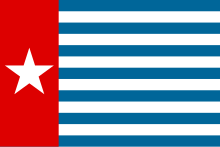Dutch New Guinea
Dutch New Guinea (also Dutch New Guinea ; Dutch Nederlands Nieuw-Guinea ; English Netherlands New Guinea or Dutch New Guinea ) was the name for Western New Guinea during the Dutch colonial period . Today it belongs to Indonesia and is divided into the provinces of Papua and West Papua (until 2003 administered together under the name Irian Jaya ).
The eastern part of the island was the British colony of British New Guinea before it became an independent state as Papua New Guinea in 1975.
history
After a few voyages of discovery and exploration in the 17th century, the Dutch East India Company (VOC) initially tried in vain in 1660 to occupy the resource-rich New Guinea . In the 19th century the Netherlands again asserted their claims to ownership of New Guinea and took the region under their rule on August 24, 1828, a Dutch settlement was established near Fort Du Bus in Triton Bay. Over the years, the Dutch government also had the administrative offices of Fakfak , Manokwari and Merauke built. However, large parts of the interior remained undeveloped. In 1885 and 1895, the British and Germans who had occupied the eastern half of New Guinea (today's Papua New Guinea ) recognized that they were part of the Dutch East Indies ; the eastern border ran along the 141st degree of longitude.
Until 1949, Dutch New Guinea was ruled by the Netherlands as part of the Dutch East Indies. When Indonesia became independent in 1949 with the Indonesian War of Independence, and thus most of the Dutch East Indies, the Netherlands retained sovereignty over Dutch New Guinea. Steps to prepare it for independence as a separate country should also give the Netherlands a responsible face as a colonial power. In 1954, however, the Dutch-Indonesian Union broke up in the dispute over New Guinea . Dutch policy towards western New Guinea was mainly influenced by political relations with Indonesia and the desire to continue to exert regional and economic influence on the region. So were z. B. sent five thousand teachers. The Netherlands emphasized political, business and civic skills. The first local sea cadets graduated in 1955 and the first army brigade was operational in 1956.
Elections were held across Dutch New Guinea in 1959 and an elected Raad (“Council”) officially took over on April 5, 1961, in preparation for independence at the end of the decade. The Dutch approved the election of a new national anthem by the council and the morning star as the new national flag on December 1, 1961.
Indonesia tried to forcibly incorporate the area into its national territory by landing troops from December 18, 1961. Tensions between the Indonesian and Dutch armed forces ensued and the territory was placed under United Nations administration under high international pressure in October 1962 and then transferred to Indonesia in May 1963. The territory was officially annexed by Indonesia in 1969 after a controversial vote ( Act of Free Choice ) was carried out by the Indonesian military .

